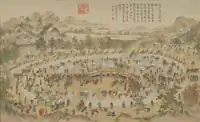Khojis
Khojis (Chinese: 霍集斯, Huò jísī, ?-1781) was a Muslim Uyghur Emir, or hākim beg,[2] of Uqturpan (also Us-Turfan, Chinese: 乌什, Wushi) in Xinjiang during the 18th century.
%252C_governor_of_Turfan%252C_who_later_settled_in_Beijing._Painting_by_a_European_Jesuit_artist_at_the_Chinese_court_in_1775.png.webp)
Khojis collaborated with Qing forces in the 1755-1757 Dzungar–Qing War, when he captured the Dzungar Khanate leader Dawachi as he fled into the mountains north of Aksu, and delivered him to the Qing.[3][4]
Khojis again collaborated with the Qing in the Amursana rebellion (1757–1759) and in the suppression of the Muslim Revolt of the Altishahr Khojas (1757–1759).[4] Khojis appears in a famous Qing Dynasty (平定伊犁回部战图册·乌什酋长献城降), arranging the surrender of the city of Uqturpan to Chinese Qing forces in 1758.
The Qing emperor Qianlong rewarded Khojis with the title of Qinwang (亲王, "Prince"), and settled him in Beijing.[2]
 Muslim Emir Khojis arranges the surrender of Uqturpan to Qing forces in 1758 (detail)
Muslim Emir Khojis arranges the surrender of Uqturpan to Qing forces in 1758 (detail) The Emir of Uqturpan surrendering the city of Uqturpan during the suppression of the Muslim Revolt of the Altishahr Khojas. 平定伊犁回部战图册·乌什酋长献城降 (1764).
The Emir of Uqturpan surrendering the city of Uqturpan during the suppression of the Muslim Revolt of the Altishahr Khojas. 平定伊犁回部战图册·乌什酋长献城降 (1764). Portrait (detail, 1775), by Ignatius Sichelbart
Portrait (detail, 1775), by Ignatius Sichelbart.jpg.webp) Uqturpan delegates (bottom group, flag "乌什") in Peking in 1761. 万国来朝图
Uqturpan delegates (bottom group, flag "乌什") in Peking in 1761. 万国来朝图
References
- "北京保利国际拍卖有限公司". www.polypm.com.cn.
- Adle 2003, p. 158.
- Adle 2003, p. 201.
- Schorkowitz 2016, p. 298.
Sources
- Adle, Chahryar (2003). History of Civilizations of Central Asia 5.
- Schorkowitz, Dittmar (14 November 2016). Managing Frontiers in Qing China: The Lifanyuan and Libu Revisited. BRILL. ISBN 978-90-04-33500-4.